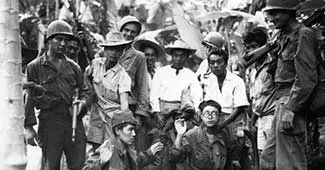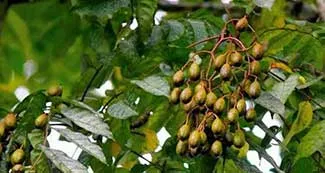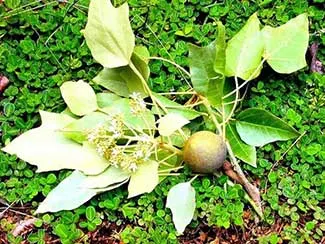Calaca, Batangas: Historic and Folkloric Notes about some of its Barrios
We continue with the series of articles dedicated to resurrecting otherwise forgotten pieces of historical and folkloric trivia about the barrios of the province of Batangas. This time, we turn our attention to the town of Calaca in western Batangas.
Information contained in these articles is taken from documents required by the Elpidio Quirino administration in 1951 of all Department of Education districts around the country to help reconstruct the nation’s history at the local level. These documents are archived at the National Library of the Philippines Digital Collections.
Not all barrios of Calaca are included in this article. Some contemporary barrios might not even have existed yet in 1953 when these documents were collected. It is also possible that no such histories were written for some barrios and if there were for still some others, these were poorly researched and not worth including. There might also have been documents that had been eroded by time and could not be digitized for inclusion in the NLP archive.
Bagon (Bagong) Tubig
This barrio supposedly got its name from a folkloric story involving a couple who was among the place’s earliest settlers. One night, the man, who was cruel and frequently whipped his wife, found that they had run out of water in the household. He ordered his wife to fetch some. The stream was far away and she needed to cross a ravine to get there. It was dark and while she walked she kept praying to God to help her get to the stream. Suddenly, she heard a noise and before long, she realized that water was flowing near the ravine. There was suddenly a “new source of water” (bagong tubig) close to where she lived, and that was how the barrio supposedly got its name.
The barrio’s establishment was roughly placed around 1886. During the latter years of the Spanish regime, the barrio’s inhabitants evacuated to other barrios to avoid being captured and held against their will by the Spaniards. They returned to rebuild their homes and lives during the American era. In World War II, they were forced to flee to the mountains again. When the Japanese became rabid upon hearing of the American landing in Batangas, inhabitants of the barrio hiked all the way to Nasugbu where they stayed for a month under the care of the Americans.
Source: History and Cultural Life of the Barrio of Bagon Tubig
Baklas (Baclas)
This barrio was established in 1941, and its name supposedly meant “eroded1.” Presumably, this had something to do with something that happened to the land in the barrio. The place was supposed to have been a wilderness during the Spanish regime and was, therefore, perfect as a hideout for Filipino revolutionary forces. It continued to be uninhabited on through the American era, until settled in 1941 by the Casanova family. In World War II, a guerrilla group under the command of one Captain F. Gagalac set up its headquarters in the barrio. People from this and neighboring barrios supplied them with food and clothing.
Source: History and Cultural Life of Barrio Baklas
 |
| A guerrilla group set up its headquarters in Barrio Baklas (Baclas) in WWII. Image credit: Guns.com. |
Borwalte
Because this barrio used to be a provisional or temporary home or camp for Spanish soldiers, it was given the name “borwalte,” which was supposed to mean exactly that, a provisional home2. The barrio was supposed to have been thickly forested during the Spanish era, and its flat lands covered with tall reeds. It was initially inhabited by two families from another barrio called Puting Bato (White Rock). The barrio continued to be sparsely populated and it was not until the American era that it was deemed necessary to appoint a barrio lieutenant, whose name was Melanio Baque. During the Japanese occupation, the inhabitants of the barrio were forced by the regime to plant their fields to cotton, great quantities of which were subsequently harvested.
Source: History and Cultural Life of Barrio Borwalte
Calantas
This barrio was supposed to have been named after a kalantas3 tree, called the Philippine cedar in English, which was “the biggest and tallest tree” that grew in the barrio during the Spanish era. It used to be a large barrio which had the sitios Sugod, Coral, Lampasan, Taklang-Anak and Balok-balok. The barrio was sparsely populated even through the 1950s, many of its inhabitants preferring to emigrate elsewhere because “no great signs of progress can be seen…”
Source: History and Cultural Life of the Barrio of Calantas
 |
| Calantas was supposed to have been named after the Philippine cedar (above). Image credit: Philippine Medicinal Plants. |
Camastilisan
This barrio was supposed to have been named after the camastilis tree, which grew big and looked “uniform, attractive and inviting” in the area. I am unable to find any references to such a plant, so we shall assume that “camastiles” is either a local or archaic term for the more familiar kamatsile or camachile, known in English as the sweet tamarind4. The barrio’s lieutenants from 1896 were Lucas Morillo, Felix Alamag, Florencio Garcia, Lupe Villalobos, Juan Villalobos, Vivano Gatdula and Alfredo Reyes. Regrettably, the document on Camastilisan seemed poorly researched and contained few other trivia worth including in this article.
Source: History and Cultural Life of the Barrio of Camastilisan
Dacanlao
This barrio was supposed to have been a swampy area where seashells called “dakans” used to abound. Because the swamp was called “lalao5,” before long people started calling the place Dakanlao or, by its Spanish spelling, Dacanlao. The barrio had two sitios named Tebag and Balagbag. Its inhabitants suffered greatly during the Japanese occupation. Many people starved and died of hunger. The survivors sustained themselves by eating corn and sweet potato. There was little rice available. The barrio’s inhabitants rarely ventured into the town proper for fear of being caught and killed by Japanese soldiers. After liberation, the community was brought closer to the school, where additional buildings were put up.
Source: History and Cultural Life of the Barrio of Dacanlao
 |
| Dacanlao was so named because it used to be a swampy place where shells called dakans were called. Image credit: Ken Ngo. |
Dila
This barrio was so named because it was shaped like a tongue, “three to four kilometers in length and about two hundred meters in width” and bounded on both sides by deep ravines. It was established during the Philippine-American War. Its original families came from the barrios of Sinisian, Pook and Agoncillo. In the early days, because the place was thickly forested and covered with tall reeds, it was considered the perfect hiding place for “insurrectos,” as the Filipino freedom fighters were called, and brigands called “tulisanes.”
Source: History and Cultural Life of the Barrio of Dila
Kaluangan
The name of this barrio was given because, among neighboring barrios and sitios, its territory was the widest, “maluang” (contemporarily, maluwang) in Tagalog. It was established during the Spanish era and its earliest settlers were from the barrio of Sinisian. Under Kaluangan were several sitios named Orasion, Pangyot, Kalawite and Deligkinto. Its barrio lieutenants from the Spanish era to the 1950s were Isidro Endozo, Gregorio Maullon, Balbino Mendoza, Nazario Endozo, Pedro de Roxas and Francisco Marasigan. Because of the barrio’s remoteness, it remained relatively unaffected by the Philippine Revolution and the wars in the next century.
Source: History and Cultural Life of Barrio Kaluangan
Lumbang na Bata
Lumbang na Bata used to be part of another barrio called Puting Kahoy, which was founded soon after the Philippine-American War. In 1916, a new barrio was created from parts of Puting Kahoy and another barrio called Lumbang. This barrio was given the name Lumbang na Bata (directly translated as “Lumbang the Child but more correctly as New Lumbang).
Source: History and Cultural Life of the Barrio of Lumbang na Bata
Lumbang na Matanda
The old or original Lumbang, this barrio was named after the lumbang tree, called the candlenut6 in English. It had two sitios called Kakawatihan and Coral. Its original settlers were the Jolongbayan and Casanova families. This barrio was the site of many bloody battles between Spanish forces and members of the Katipunan during the Philippine Revolution. During World War II, many inhabitants of the barrio joined the guerrilla movement. Those who did not supported the guerrillas with food and clothing. Six Japanese soldiers were killed by the locals late in the war. Because of the barrio’s involvement with the underground movement, it was also frequently visited by Japanese soldiers.
Source: History and Cultural Life of the Barrio of Lumbang na Matanda
Machinan
This barrio, due south of the provincial road, was once thickly forested with trees and bamboo thickets. In these trees lived many monkeys (matsing in Tagalog) which could be seen playing along the banks of the Kawang River early in the morning or late in the afternoon. The barrio was so named because of these animals, one of which terrorized locals because it ran after people. The locals referred to this monkey as “putting kilay” (white brows). Most of the barrio’s inhabitants were either farmers or, because of its proximity to the sea, fishermen.
Source: History and Cultural Life of Machinan
Madalunot
This barrio was named after a shrub that “lined all sectors” of the place, the dalunot7, alternatively called “agdalamai” in Tagalog. It was founded circa 1866 and had several barrios named Batuhan, Calamundingan, Cahigpitan, Ranzo, Matipok, Kay Tatlong Ulo, Kay Tumbaga, Kay Tamayo and Calicanto. During the Spanish era, Madalunot was something of a refuge for people who had fled Spanish persecution. During the American colonial era, unfortunately, this barrio was often beset by thieves who preyed on travelers along the narrow trail to get to and from the barrio.
Source: History and Cultural Life of the Barrio of Madalunot
Pantay
Barrio Pantay was fondly called Piela by the Spaniards. Unfortunately, the source document could not cite any story about how it came to be known as “Pantay,” although it conjectured that the name could have been given because of the levelness of its land. Among the original settlers of this barrio were the families of Potenciano Bautista, Macario Caldo and Lucia Matalog. During the early years of the American era, many of inhabitants of the barrio had to go to the town proper as the Americans enforced their concentration camp policy to isolate the Filipino freedom fighters under General Miguel Malvar. During World War II, like many barrios of Calaca, Pantay supported the guerrilla movement. This brought punitive action from the Japanese so that the barrio’s inhabitants frequently had to evacuate to avoid retaliatory action. In 1945, American P51 “Mustang” fighter planes descended upon the barrio to strafe Japanese positions, killing six Japanese soldiers.
Source: History and Cultural Life of the Barrio of Pantay
Puting Bato
The old name of this barrio was Kulong-kulong. According to folklore, the barrio’s current name was given by Spaniards who found a big white boulder in a pond as they passed it. The barrio, which was established in 1836, had three sitios named Talisay, Bulwarte and Coral. Its original families were those of Juan Maullon, Juan Sacro, Severo Vidal, Lucas Vidal, Nicolas Padilla, Francisco Salazar, Telesforo Mendoza, Matea Bengua, Pedro Mendoza, Alejandro de los Reyes, Rafael Magpilo, Crisanto Comia, Andres Bathan, Sinforoso Cauntay, Romualdo Arriola and Manuel Marasigan.
During the latter part of the Spanish regime, many of the barrio’s inhabitants fled to the mountains to avoid persecution by the Guardia Civil. In 1898, people lived in fear as fighting in the Philippine Revolution spilled over to the barrio. In World War II, young men of the barrio joined up with the guerrilla units of Colonel Gagalac and one Major Olegario S. de Joya.
Source: History and Cultural Life of Barrio Puting Bato
Salong
Salong used to be the leading sitio of Lumbang until it became a separate barrio. It used to be covered with tall reeds until settlers started to arrive and plant the fertile soil, which was excellent for the cultivation of rice. Because this barrio had access to the sea, many of its inhabitants also became fishermen. The barrio’s original lieutenants were Mariano Talaos, Esperidion Talaos, Faustino Mendoza, Miguel de Gala, Sixto Ornales and Mariano de Castro.
Source: History and Cultural Life of Salong
Sinisian
According to the source document, the barrio’s name was related to the frequent attack by armed brigands (tulisanes) and how locals would say whenever they came “nagsisian ang mga taga rito.” The document, however, failed to explain if “nagsisian” came from the root word “sisi,” meaning to blame. Therefore, the context of the statement is not definitive.
At any rate, this barrio’s earliest families were those of Narciso Atienza, Pastora Dimailig, Blas Cabrera, Eusebia Dimailig, Felisa Dimailig, Juan Villanueva, Quintana Marasigan, Maria Alcaraz, Sixto Alcaraz, Faustino Alcaraz, Faustino Comia and Eleuterio Enriquez. Like other barrios, inhabitants of Sinisian had to live in fear of the Guardia Civil during the latter part of the Spanish regime. During World War II, many of the barrio’s young men also joined the guerrilla movements against the Japanese invaders. Houses and school buildings were destroyed by the Japanese.
Source: History and Cultural Life of the Barrio of Sinisian
2 As I myself do not speak Spanish, I tried to corroborate this using several online translators without success. It is possible the term is colloquial or has become archaic. If any reader can confirm the meaning of the word, please do so using the comments section below.2
3 “Kalantas,” online at Philippine Medicinal Plants.
4 “Kamatsile,” online at Philippine Medicinal Plants.
5 TagalogTranslate.com says that the Tagalog word for swamp is “lablab.”
6 “Lumbang,” online at Philippine Medicinal Plants.
7 “Dalunot,” online at Philippine Medicinal Plants.



